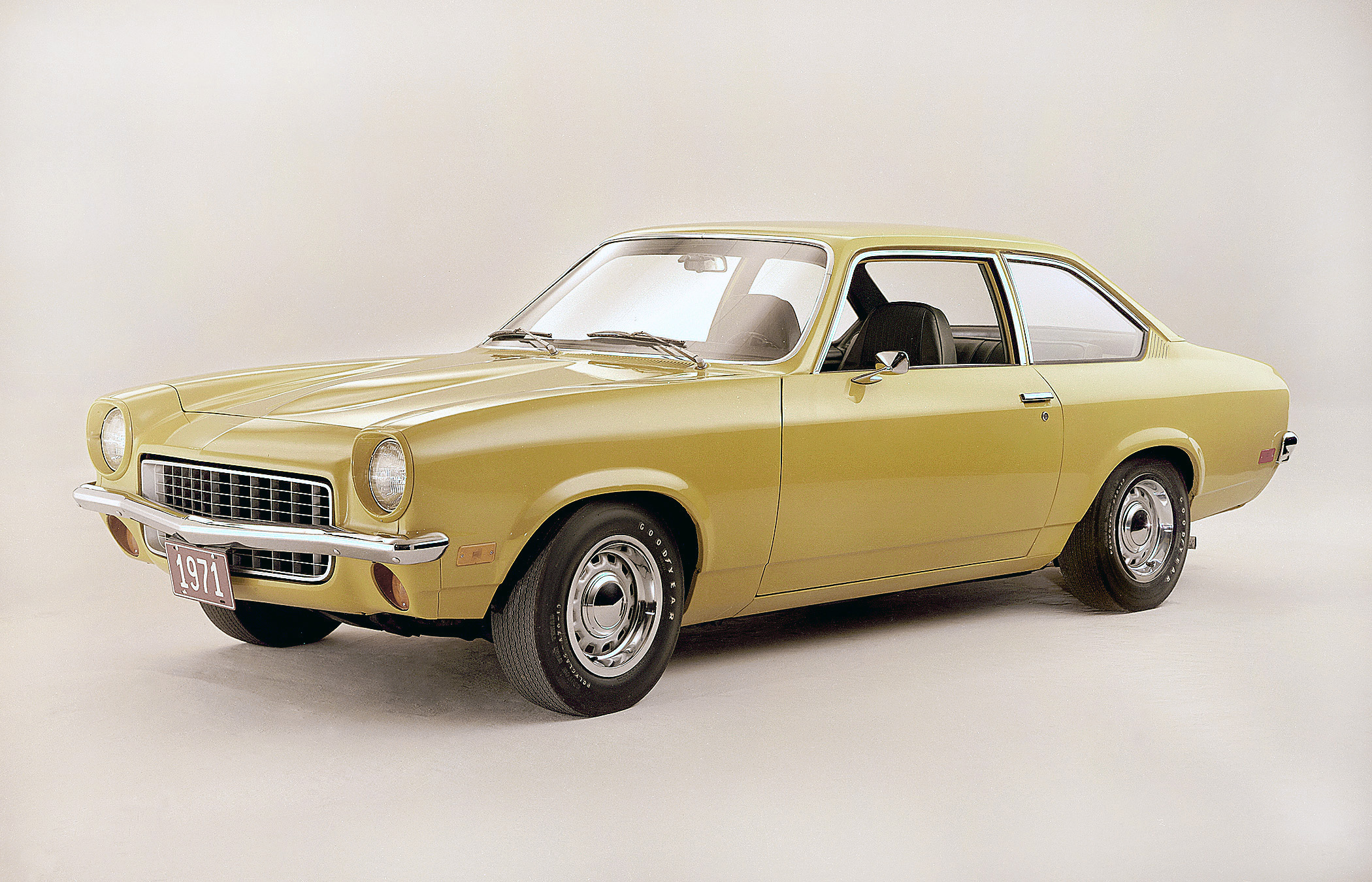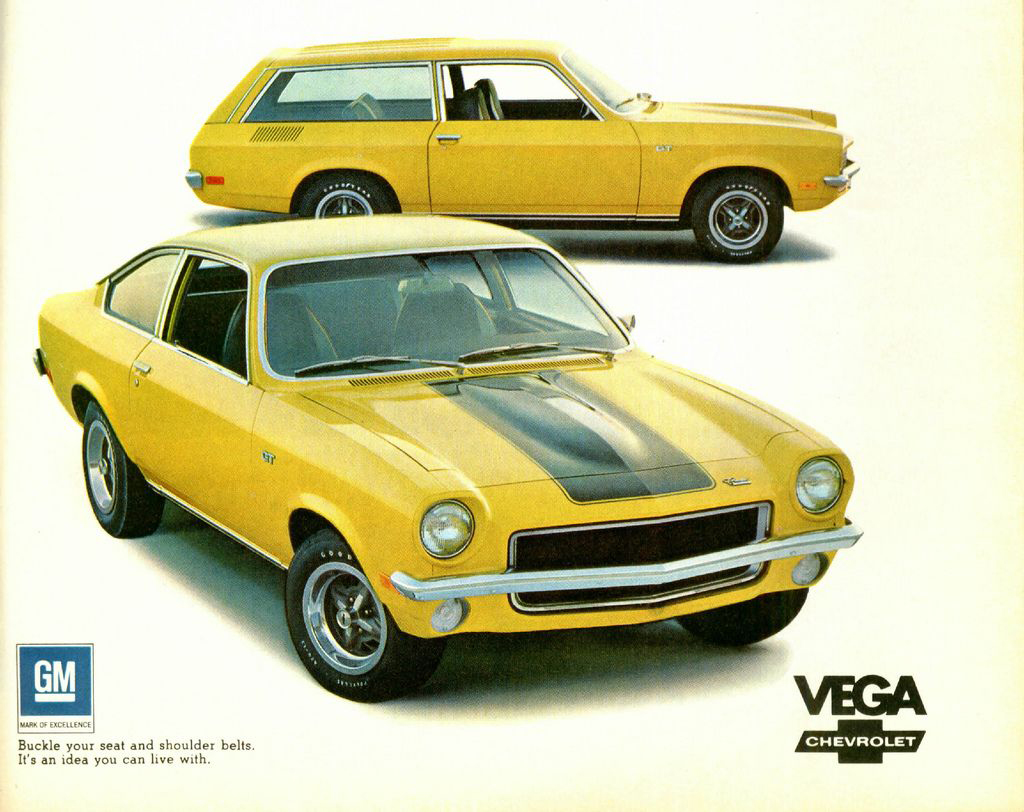
A Look Back at the Vega Platform H: 50 Years Later, Praise Outdistances Disfavor
For model-year 1971, Chevrolet launched the Vega H-Body to compete with Ford, AMC and econo-imports, and it was greeted with enthusiasm from the auto press. The subcompact drew early raves and was named 1971 “Car of the Year” by Motor Trend and “Best Economy Sedan” in 1971, 1972 and 1973 by Car and Driver readers. Vega, also called “the H Body,” had a 97.0-inch-wheelbase, and the econocar saw more than two million versions of Vega – Notchback, Hatchback, Kammback, Panel Express Delivery and Cosworth -- produced between 1971 and 1977, with a high-water mark of 460,374 in 1974.
Named after the brightest star in the constellation Lyra, Vega flamed out in seven years and was cut from the line. The car quickly became one of those love-it-or-hate-it vehicles, and its supporters were equaled by its detractors. But 50 years later, the Vega H-Body remains a classic for many reasons.
The Chevrolet Vega was conceived in 1959, when compact cars were beginning to sell in America, with the market served largely by the Volkswagen Beetle, Datsun and Toyota, as well as the American Studebaker Lark and Rambler American. Chevrolet entered the compact fray in 1960 with Corvair, to compete with Ford Falcon and Plymouth Valiant, and all three hit the ground running. Other small cars were not compacts as we see them, and were adaptations of mid-size sedans -- Chevrolet Nova, Ford Maverick and AMC Hornet were among those – and the public yearned for a true subcompact.
By the end of the decade, John DeLorean had been reassigned from head of Pontiac Division to the Chevrolet Division, and took over Vega (among other challenges). Vega was already set to build, and DeLorean added a few tweaks, but the engineers and designers shipped it, pretty much as they imagined it when it went live in September 1970. A series of teaser ads led up its launch, with four available variants of the H-Body. The Notchback sedan and Kammback wagons shared rooflines (and thus doors and other components); the more popular Hatchback had a lower roofline and shared a fold-down rear seat with the Kammback. The cars were identical from the cowl forward. The Panel Express was designed to be a light delivery truck and a GT version of Vega could be ordered, which brought a little more power (110hp vs. 90) through use of a two-barrel carburetor and slightly “warmer” cam grind, along with full instrumentation on the dash.
 H-Bodies, introduced with the ’71 Vega were available with various GM engines, solid rear axle and unibody construction. By 1973, Pontiac Astre, a rebadged version of Vega launched in Canada and hit the U.S. market in 1975. Other H-bodies included Chevrolet Monza, Buick Skyhawk and Oldsmobile Starfire for model-year 1975, and Pontiac Sunbird’s H-Body came into play for 1976.
H-Bodies, introduced with the ’71 Vega were available with various GM engines, solid rear axle and unibody construction. By 1973, Pontiac Astre, a rebadged version of Vega launched in Canada and hit the U.S. market in 1975. Other H-bodies included Chevrolet Monza, Buick Skyhawk and Oldsmobile Starfire for model-year 1975, and Pontiac Sunbird’s H-Body came into play for 1976.
The Vega and the Astre were discontinued at the end of the 1977 model year, while the Monza, Sunbird, Skyhawk, and Starfire continued through 1980. The GM J platform replaced the H platform in 1981, though the H platform was designated for full-size GM front-wheel-drive cars in the 1980s, and served as the basis for GM’s second-generation downsized full-sized sedans including Buick LeSabre, Oldsmobile 88 and Pontiac Bonneville.
The base Vega engine was a single-barrel 90-hp 140 CID aluminum-block L4. A two-barrel version delivered 110 hp, and in 1972, a prototype that never saw the light of day, had an all-aluminum 302 small-block V-8. Chevrolet hand-built 5000 122 CID L4 Cosworth Twin-Cam engines for the 1975 Cosworth Twin-Cam Vega. And in 1973, GM made plans to install the GM-rotary Wankel engine in for the 1975 Monza 2+2, but the engine was canceled.
 Manufactured at Lordstown Assembly in Ohio, and South Gate Assembly in California, as well as in plants in Canada and Mexico, the basic Vega was priced at $3249 in 1971, but lofty goals helped create the sports-inclined Cosworth that was priced at $5918 in 1975, only $892 below Corvette, and was soon priced out of the market.
Manufactured at Lordstown Assembly in Ohio, and South Gate Assembly in California, as well as in plants in Canada and Mexico, the basic Vega was priced at $3249 in 1971, but lofty goals helped create the sports-inclined Cosworth that was priced at $5918 in 1975, only $892 below Corvette, and was soon priced out of the market.
The Chevrolet Vega pioneered a number of product development processes at GM, including employing new production methods and technologies, and it introduced a novel means of rail shipment – vertically on specially designed rail cars, which could hold 30 cars instead of the 18 a standard auto carrier held.
Vega was good-looking, a decent driver and sold in big numbers early on, but uninspired engineering tweaks and the focus to keep a low price, soon fueled Vega’s demise. When Vega displayed a propensity for rust after cold East-Coast winters and salted roads, and corrosion even in West Coast Vegas, the public changed praise to derision. Additionally, an inadequate cooling system led to oil burning, coolant leaks, and dead engines.
The luster had worn off and Vega was discontinued. But just as the star it was named after, Vega shone brightly on the automotive scene and deserves classic respect, as we celebrate 50 years since it hit and took over the car world’s consciousness.
To learn more about the 2021 Carlisle GM Nationals, special displays of the weekend, including the 50th birthday of the Vega and H Platform and more, visit the car show page direct via the Carlisle Events web page. Register to show or purchase spectator tickets too.
Mike Blake, former editor of KIT CAR magazine, joined Carlisle Events as senior automotive journalist in 2004. He's been a "car guy" since the 1960s and has been writing professionally for about 30 years.
Book with a preferred Hotel
Book online or call (800) 216-1876








Leave a commentOrder by
Newest on top Oldest on top